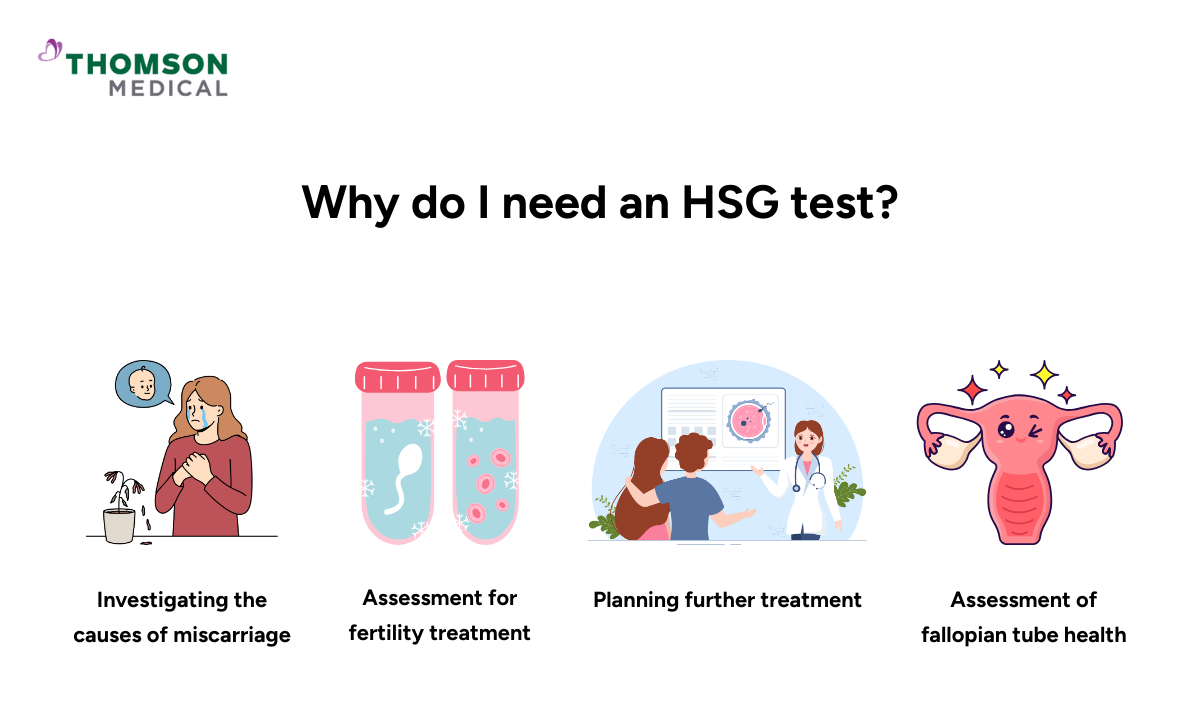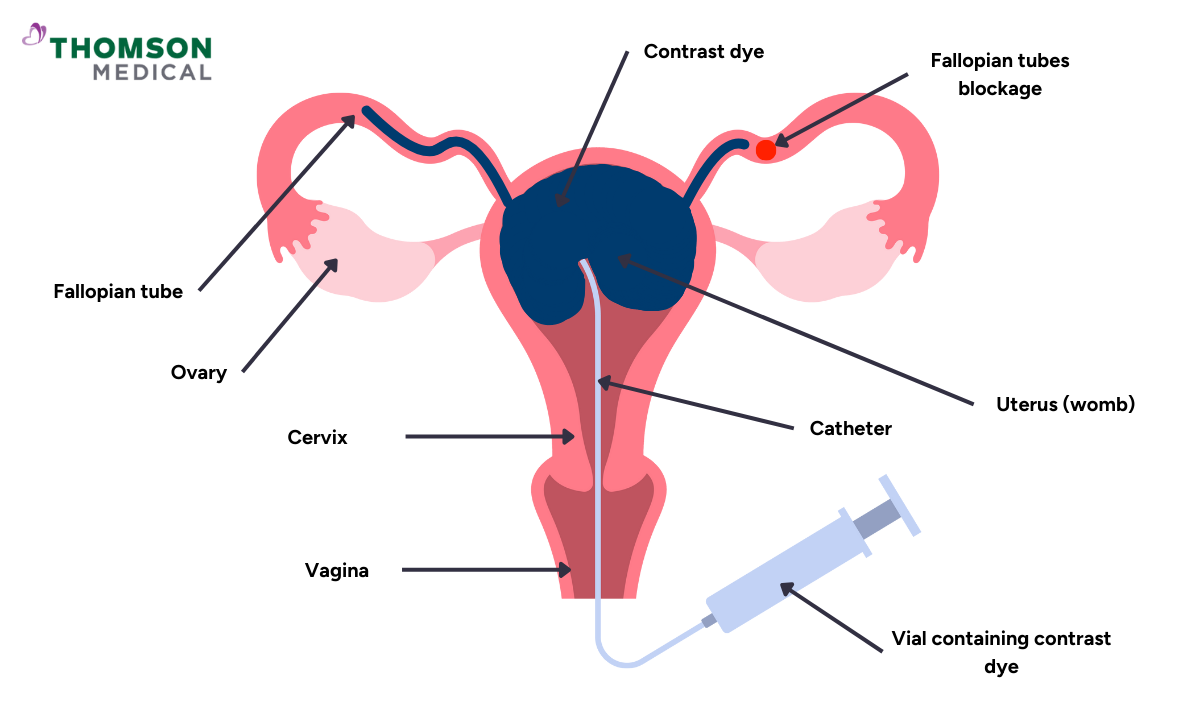What is a hysterosalpingogram (HSG)?
An HSG test is a specialised X-ray test that uses a contrast dye to assess the internal cavity of the womb (uterine cavity) and fallopian tubes. This test is commonly used to investigate fertility concerns or assess general reproductive health to help increase the chances of conception.
In Singapore, HSG testing is available at public or private hospitals, polyclinics, and fertility clinics. It is usually done as an outpatient procedure and can be done as a stand-alone fertility test or included as part of a health screening package.
Why do I need an HSG test?

Your healthcare provider may suggest an HSG test if you're experiencing subfertility or infertility problems. This is because this imaging test can detect fertility problems such as blockages in the fallopian tubes or an abnormality in the uterine cavity.
A blocked fallopian tube can cause infertility because it prevents sperm from travelling down the fallopian tube to reach the egg and fertilise it. Similarly, the fertilised egg's embryo can't travel through the tube to the womb, where it can develop into a foetus.
In addition, this test is also used to evaluate the uterine cavity to see if there are any abnormalities such as polyps, fibroids, adhesions (scar tissue), or abnormal shapes that can affect fertility or cause miscarriages.
As well as assessing fertility issues, this medical imaging can also be used to assess reproductive health, which includes:
Investigating the causes of miscarriage:
If you have had miscarriages, an HSG scan can be used to look for uterine abnormalities that may interfere with embryonic implantation or increase the risk of miscarriage.
Assessment of fallopian tube health:
Other than detecting blockages, this imaging test can also detect swelling or inflammation in the fallopian tubes that may be caused by infection or previous surgery.
If initial imaging suggests blocked fallopian tubes, your doctor may recommend additional tests like hydrosalpinx ultrasound or saline infusion sonohysterography for detailed visualisation.
Assessing the tubal ligation (sterilisation) procedure:
After a tubal ligation procedure, HSG is performed to ensure that the fallopian tubes are completely blocked, making pregnancy unlikely.
It can also be done after a tubal reversal to check that the procedure was successful and that the fallopian tubes are open again.
Planning further treatment:
An HSG may show irregularities in your uterus that your healthcare provider can use to plan further imaging, such as sonohysterography and hysteroscopy.
A sonohysterography is used to further define the results of an HSG and provide a diagnosis, while a hysteroscopy may be used to treat specific conditions affecting the uterus.
Assessment for fertility treatment:
Before starting fertility treatments such as in vitro fertilisation (IVF), HSG is commonly used to rule out any structural problems with the uterus and fallopian tubes.
By identifying issues such as blockages in the fallopian tubes and other abnormalities in the uterine cavity, the HSG test helps healthcare providers diagnose the causes of infertility or recurrent miscarriage and plan appropriate treatment.
If you would like more information about the HSG test, request an appointment with Thomson Medical. Our specialists can help explain this medical imaging in more detail and assist you with further consultation to determine if it's suitable for your medical condition.
Gynaecologist that can do HSG test
Loading...
How to prepare for an HSG test
Before the procedure, your healthcare provider may recommend the following preparations to ensure that the test goes smoothly:
Take a pain medicine 1 hour before the procedure to reduce cramping and discomfort.
Take antibiotics to reduce the risk of infection, especially if you have a history of pelvic infections.
Bring a sanitary pad to use after the procedure, as some spotting or contrast dye leakage is common.
Wear dark-coloured clothing to make you feel more comfortable if you experience vaginal bleeding or leakage after the procedure.
An HSG test is usually done between 5 to 10 days after the first day of the last menstrual period before the time of ovulation. The timing helps to avoid interfering with a possibility of pregnancy and gives the best image result, as the womb lining is thinner.
It's important to tell your healthcare provider if you are currently pregnant or menstruating, or if you have a pelvic infection, so they can reschedule the test. Don't hesitate to ask any questions or concerns you may have about the procedure.
During the HSG Test

After the preparation steps, the procedure begins and is performed by a gynaecologist and an X-ray technician. The HSG test is usually an outpatient procedure that lasts between 15 and 45 minutes. Here's how the procedure is usually carried out:
You may be asked to change into a hospital gown beforehand and lie down on the examination table with your knees bent and your legs open.
The X-ray machine will be positioned above the womb (uterus) and fallopian tubes so the healthcare provider can observe it in real time.
Your healthcare provider will insert a tool called a speculum into your vagina to get a better view of the cervix (the opening of the womb).
After that, they will clean your cervix and insert a small, thin tube called a catheter through it and gently into your womb.
Once the catheter is in your womb, your healthcare provider will remove the speculum and slowly inject the contrast dye. This dye will outline your womb and fallopian tubes on the X-ray.
The doctor may ask you to move around to observe how the dye passes through the fallopian tubes. Several X-ray images will be taken as the dye fills the uterus and fallopian tubes.
If the fallopian tubes are open, the dye solution will spread to your bowel and be absorbed. If the dye does not spill out, it may mean that the tubes are blocked.
After the pictures have been taken, the catheter will be removed from the womb, and the procedure is concluded.
What happens after the test?
After the test, you can go back to your normal activities on the same day. However, you may need to wear a sanitary pad to catch any extra dye solution that may leak from the vagina. It's also normal to feel some mild discomfort or cramping.
After the test results are back, your healthcare provider will arrange a follow-up appointment to discuss your results and advise you on the next steps.
If the HSG test shows a blockage, your provider may recommend additional procedures, such as a hysteroscopy for further diagnosis or fertility treatments that don't require the opening of your fallopian tubes if you're planning to conceive, such as in vitro fertilisation (IVF).
How much does an HSG test cost in Singapore?
In Singapore, the HSG test is available at public or private hospitals, polyclinics, or a fertility clinic. The cost of the test varies depending on whether it is done as a stand-alone fertility test or as part of a health screening package and the healthcare facility chosen.
In general, the cost of the HSG assessment is between SGD 600 and 800 in a private clinic. However, the cost may be lower if this procedure is performed in a public hospital.
To help cover the cost, you’ll be able to use up to SGD 300 per year from your MediSave account at select clinics. If you have private insurance, check with your provider to see if an HSG test is covered under your policy.
For detailed fee information and payment options, request an appointment with our specialists at Thomson Medical today.
What are the risks of this test?
Although radiation is used to record X-ray pictures, the amount is very low, so the HSG test is generally safe with minimal risk. However, you may experience some side effects after the procedure, such as:
Abdominal cramps
Dizziness
Nausea
Light vaginal bleeding or spotting
Allergic reaction to the contrast dye (especially if you have a history of allergies to iodine or seafood), such as rash, itching, or swelling
These symptoms usually go away on their own within a day or two.
When to seek medical attention
Although serious complications are rare, it’s important to know when to seek medical advice. You should contact your healthcare provider right away if you notice any of the following symptoms after the procedure, which could be signs of infection:
Experiencing a fever
Heavy bleeding
Severe pain
Foul-smelling vaginal discharge
Vomiting or fainting
FAQ
What is the HSG test for?
An HSG is an X-ray procedure that uses a special contrast dye to visualise the insides of your uterus and fallopian tubes. It helps your doctor assess for abnormalities, such as blockages or structural issues, that could affect fertility or cause miscarriages
How painful is the HSG test?
You may experience mild to moderate abdominal cramps or discomfort during and shortly after the procedure. Over-the-counter pain medications, such as non-steroidal anti-inflammatory drugs (NSAIDs), can help ease this discomfort. The pain is usually brief and subsides soon after the test.
Can an HSG test improve fertility?
Yes, the HSG test has been shown to improve fertility rates, especially when oil-based contrast dye is used. During the HSG, a contrast dye is injected into your uterus and fallopian tubes, and X-ray images are taken to check for blockages or abnormalities.
The process can help flush out minor blockages, which may increase your chances of becoming pregnant. Tubal flushing can also be done as part of an HSG (with X-rays) or as a separate procedure under ultrasound or during surgery.
How do you know if your fallopian tube is blocked?
Blocked fallopian tubes usually do not cause symptoms. If the dye fails to pass through one or both fallopian tubes on the X-ray images during an HSG, it indicates a blockage.
Some women with blocked tubes may experience pain on one side of the abdomen, but most often, blockages are discovered during fertility investigations rather than from symptoms alone.
What is the 10-day rule for HSG?
The 10-day rule for HSG is scheduling the HSG procedure between 5 to 10 days after the first day of the last menstrual period before the time of ovulation to ensure you are not pregnant during the X-ray procedure.
You may be required to do a pregnancy test prior to the procedure to ensure you are not pregnant. You may be required to remain abstinent from sexual intercourse from day 10 of your cycle until after the day of the procedure to ensure you are not pregnant.
Are you awake during HSG?
Yes, you are awake during the HSG procedure. It is performed in an outpatient setting and does not require anaesthesia. You may feel some cramping, but the test is generally quick and well tolerated.
The information provided is intended for general guidance only and should not be considered medical advice. For personalised recommendations and tailored advice, please consult a specialist at Thomson Medical. Request an appointment with Thomson Medical today.
For more information, contact us:
Thomson Fertility Centre
- Paragon: 6252 7766
Thomson Specialists (Women's Health)
Thomson Women's Clinic
- Novena:
6592 6686 (Call), 8611 8986 (WA) - Bukit Batok:
6569 0668 (Call), 8686 3525 (WA) - Choa Chu Kang:
6893 1227 (Call), 8282 1796 (WA) Jurong:
6262 8588 (Call), 6262 8588 (WA)- Katong (female doctor):
6970 2272 (Call), 8611 9020 (WA) - Punggol:
6243 6843 (Call), 8811 0328 (WA) - Sembawang: 6753 5228
- Sengkang: 6388 8125
- Serangoon (female doctor): 6382 3313
- Tampines: 6857 6266
- Tiong Bahru: 6276 1525
